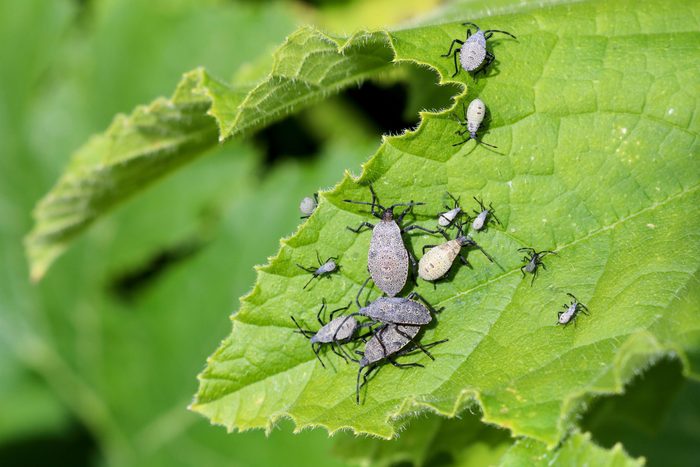Here’s How to Keep Squash Bugs Out of Your Garden
Updated: Nov. 03, 2022

If you're a gourd grower, here's how to keep squash bugs out of your garden so they don't ruin your prize pumpkins or cucumbers.
Our editors and experts handpick every product we feature. We may earn a commission from your purchases.
Never heard of a squash bug? That’s understandable. Although well-known to farmers and avid backyard gardeners, unless you’ve cultivated cucurbits (gourds) like squash, zucchini, pumpkins, cucumbers, melon, etc., you may not have encountered this bug.
Here’s what you need to know about squash bugs, how to keep them out of your vegetable garden, and what to do if they’re already there.
What Are Squash Bugs?
Defined as a “true bug,” squash bugs (anasa tristis) are insects with hypodermic-needle-like mouth parts that suck the life out of young, tender plants by extracting subsurface fluids.
Looking somewhat like a stink bug, squash bugs measure around 5/8-inches long. They’re dark gray to dark brownish-gray with orange and brown stripes on their abdomens.
Dealing with a box elder bug infestation? Here’s how to solve the problem.
Their tiny, oval-shaped eggs are typically copper or bronze, about 1/16-inch long. Eggs hatch in about 10 days with nymphs going through five stages of growth. They reach full maturity in around four to six weeks.
Young nymphs start out with light green bodies with black heads and legs. As they grow, they turn light gray, and finally to a brownish-gray.
Learn how to get rid of slugs and snails in the garden. Plus, if you see spotted lanternflies in your yard, here’s what you should do.
How Do Squash Bugs Damage Yards and Gardens?
These problematic pests are capable of laying tons of tiny eggs on the undersides of leaves. If left unchecked, they could kill your plants and transmit Cucurbit Yellow Vine Disease (CYVD). This is a bacterium that, according to the U.S. Department of Agriculture (USDA), could result in serious losses to susceptible cucurbit crops. Early detection is critical.
Discover 8 bugs you should never kill.
Signs of Squash Bugs
Squash bugs can live through the colder months (overwinter) in plant debris, around foundations and under rocks. They become adults in spring when they begin heavy feeding. They break apart plant tissues, disrupt the water flow and essentially drain nutrients from a plant’s sap. If not dealt with in a timely manner, your harvest could be ruined.
Signs you have squash bugs include:
- Sightings of actual squash adults, nymphs or egg clusters in the yard;
- Small, yellow lesions on leaves, stems and vines that may turn darker over time;
- Leaf edges that have a burnt-like, crispy appearance;
- Wilted stalks and leaves, even though the plants have been regularly watered;
- Dead plants.
Learn how to get rid of aphids on milkweed plants.
How To Get Rid of Squash Bugs
It can be a challenge to combat squash bugs. Here are a few ways to thwart a squash bug invasion:
- Scrape eggs stuck to the underside and stem of leaves and smash them so they don’t hatch into nymphs.
- If you see nymphs, pick them off plants ASAP, because adult squash bugs are much harder to kill.
- Introduce parasitoid insects like the tachinid fly, which lay their eggs around the thoraxes of squash bugs. When the fly eggs hatch, the larvae burrow into the squash bug’s body and slowly kill it.
- Insecticides available to home gardeners are generally not effective against adult bugs. However, targeting immature nymphs has shown some success.
Here’s how to get rid of the 10 worst garden insects.
How To Prevent Squash Bugs
As reported by Jeffrey Hahn and Suzanne Wold-Burkness of the College of Food, Agricultural and Natural Resource Sciences at University of Minnesota Extension, here are the best ways to protect your cucurbit plants from squash bugs:
- Keep your plants healthy (fertilize properly and water regularly);
- Plant early to cultivate larger plants which tend to be hardier and more resilient against squash bugs;
- During the growing season, remove debris to eliminate places for squash bugs to hide;
- Clean up cucurbit plant matter in the fall to reduce the number of squash bugs that will hang around over the winter.
Other non-chemical, biodiverse-centered approaches:
- Engage in companion planting, a method that uses other plants as pest deterrents. Radishes, nasturtiums, marigolds, bee balm and catnip do a good job repelling squash bugs.
- Use floating row covers to create a barrier that prevents bugs from feeding and laying eggs on your plants.
Pro tip: Floating row covers should be removed when flowers begin to form so pollinators can access the blooms.
Next, learn how to control a Japanese beetle infestation.



















